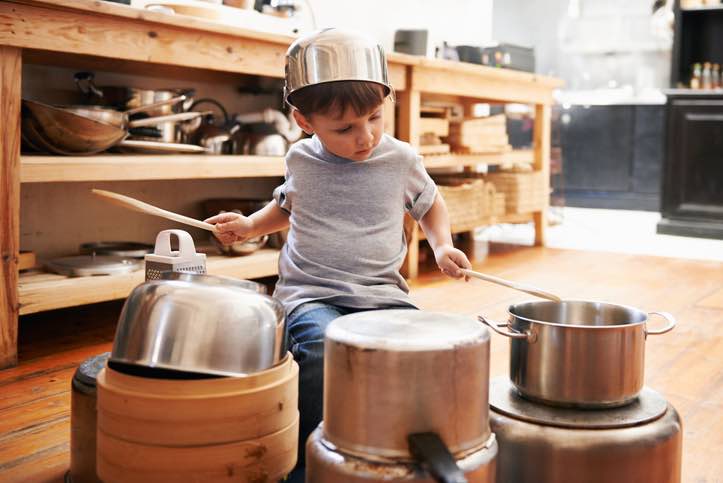The Benefits of Child-Led Parenting for Kids and Parents

There’s not exactly a lack of parenting styles out there. And this means you’re not sure which one is the “right one” for your family. Have no fear! You aren’t alone. Plenty of parents are in the same situation as you.
If you’re not into helicopter parenting or lawnmower parenting, or if you’re just on the lookout for a style that fits your fam, we’ve got the info you need on child-led parenting and the reasons to consider this kid-centric style.
Related: Find Your Parenting Style: Are You an Extreme Parent?
What Are the Different Parenting Styles?
Parenting styles or parenting approaches aren’t exactly new. You may have heard about gentle parenting, positive parenting, or helicopter parenting in recent years. People have been researching the pros and cons of different types of parenting since all the way back in the 1930s according to a literature review published in the journal Childhood Obesity.
Child-led parenting is a new sub-category of one of the three primary parenting styles identified in the 1960s by family researcher Diana Baumrind. Baurmind defined three main parenting approaches: authoritative, authoritarian, and permissive.
These styles are based on the degree of warmth, control, and structure the parents exhibit.
Authoritative parenting
This is a nurturing, responsive style. But, as the American Psychological Association (APA) notes, authoritative parenting also includes firm limits. Parents who use this style explain rules instead of dictating them, reason with their children, and are open to two-way discussions.
Authoritarian parenting

The authoritarian parenting style doesn’t include the dialogue that you would find with authoritative parents. Instead, the parents are strict and have high expectations that their children will follow their rules. Think of this style more like a dictatorship.
Permissive parenting
Permissive parents have the warmth and understanding of authoritative parents. But they don’t have the rules. These parents don’t set limits and may not closely supervise their children.
Additional studies by researchers Eleanor Macoby and John Martin identified a fourth style known as uninvolved parenting. This is an unresponsive, rejecting type of style that can result in children with low self-esteem.
Even though these four generally accepted styles have become the pillars of parenting theory, recent research has led to the development of other sub-categories. And, this is where child-led parenting comes in.
What Is Child-Led Parenting?
Child-led parenting is a sub-style of the authoritative approach. As the name implies, child-led parenting revolves around the idea that the child leads the way.
Parents are warm, responsive, and communicate with their children. While they do step back and let the child make their own decisions or explore activities and concepts in their own individual way, they don’t fall into the permissive style.
Permissive parents tend to remove themselves from the equation. Authoritative parents (and child-led parents) are fully present but often watch quietly from the sideline.
Like authoritative parents, child-led parents don’t nix the notion of rules. These parents have rules and will enforce them when necessary. This provides a structure or framework for the child to feel supported and for the caregivers to provide the guidance the child needs.
But it doesn’t dictate what your little one does or how they do it. It takes the child’s feelings into account and is based on child development milestones.
What Is Child-Led Learning?
Are you wondering if child-led parenting and child-led learning are the same thing? Both put children at the center of the action. Child-led parenting is the approach that a mom, dad, or guardian/caregiver takes at home.
Child-led learning is the way the little one builds new skills, develops new abilities, and (as the name implies) learns in the early childhood education setting, in the home environment, or elsewhere.
Allowing Kids to Learn at Their Own Pace

This type of educational strategy encourages the child to engage in the learning process and explore their interests in a way that makes sense to them. Every child is an individual, learns in their own way, and meets milestones at their own pace. A child-led learning approach accounts for these individual differences and helps the child to create meaningful learning experiences.
Are Montessori Schools Child-Led Learning?
Montessori schools are a prime example of child-led learning. Dr. Maria Montessori developed an educational program that takes a child-centered approach. Over a century ago Dr. Montessori turned her observations and research into a philosophy that has since grown into a network of schools and programs across the globe.
Along with formal early childhood schools, the Montessori approach is also popular with homeschooling parents. This philosophy breeds independence by encouraging young children to learn at their own pace and explore classroom content in their own way.
Related: The Best Montessori Toys For Babies and Toddlers
What Is Child-Led Play?
Like child-led learning, child-led play also puts your kiddo at the center of the educational, developmental, or other experience. Again, this doesn’t include a completely hands-on or permissive style.
Even though your child is in control of their playtime, you are still present and there to guide or scaffold the experience.
Parents also need to maintain a physical presence to supervise play. In other words, you need to make sure that your child stays safe when they finger paint, run through the yard, dance around the living room, or engage in any other activity.
What Are the Benefits of Child-Led Parenting?
According to info from Michigan State University, child-led play can help little ones to develop a greater sense of purpose, improve self-worth, and give them control over their environment.
-
Child-Led Parenting Helps Kids Develop a Sense of Self
Child-led parenting focuses on empowerment and helps kids develop a unique identity and a stronger sense of self-worth than more authoritative parenting styles. Rather than making good choices like going to bed early to avoid punishment or “because Mom said so,” it allows kids to reason things out on their own.
An example of a lesson of child-led parenting would be “I want to go to bed early because I feel better when I go to school and the morning, and have time to have a good breakfast.”
-
Child-Led Parenting Gives Kids a Sense of Control
The freedom to try new things without judgment helps kids gain a sense of control over their day-to-day life that most young children often don’t have. Having input even on small things like games or snacks helps kids feel more comfortable and engage in what they are doing or learning.
-
Child-Led Parenting Encourages Creativity and Problem-Solving
Instead of the child feeling like they have to learn or play in a specific way that an adult (that’s you!) dictates, they can create their own experiences. This can change your child’s behavior and reduce activity-related frustration. It can also help them to build a greater sense of self-worth, think in new and creative ways, and overcome obstacles.
Are There Cons of Child-Led Parenting?
With all the pros of child-led parenting, are there reasons to reconsider trying or using this technique? Like any other type of parenting, the child-led style could have some drawbacks.
-
Giving Your Child Too Much Freedom Can Be Dangerous
Even though child-led doesn’t equal permissive parenting, the two have lines that are easy to blur. This can result in too much freedom or freedom that the child isn’t ready for. Before you let your little one lead the way, think about their decision-making ability, overall developmental level, and realistic expectations for their age.
-
Child-Led Parenting with No Rules Can Make Kids Bratty or Spoiled
You may also need to adjust your view of child-led as you start to use this style. While a take-a-step-back approach can help your child to build self-esteem and independence, a completely hands-off style may cause problems.
A child with little or no rules/boundaries may act out, demonstrate rebellious behaviors, or have difficulty at school or in any other structured setting.
-
Child-Led Parenting Can Blur the Boundaries Between Parents and Child
Remember, you are the parent and not your child’s BFF. It’s beneficial for a child to lead themselves in play or learning activities. It is not so beneficial for the child to lead the parent. An overly permissive style of child-led parenting can lead to this scenario.
But this doesn’t mean you should nix the notion of letting your little one lead the way. Instead, take some time to review the cons, think about how they could affect your child or your family, and weigh your options.
How Do You Practice Child-Led Parenting?
More specifically, how can you balance the permissiveness of a child-led approach with the structure your kiddo needs? To effectively use this type of parenting approach:
Set rules
Create general rules for your child to follow at home, school, and when going out with others. Important rules for parents to establish with young kids include safety rules, appropriate behavior rules, personal hygiene rules, and general social skills.
But instead of laying down the law, discuss the rules with your child, parents who practice child-led parenting may involve them in writing out their own house rules and brainstorming ideas together. Inviting your child to design a few rules of their own will help them feel heard rather than overly controlled.
Set boundaries
Again, you are your child’s parent and not their best friend. This means your child shouldn’t treat you or talk to you in the same way that they would with a peer.
Let your child pace themselves. Is it taking your preschooler hours to finish a finger painting, puzzle, or other activity? That’s okay. Child-led learning happens at different rates. Give your child the time they need and let them set their own pace.
Provide choices
Setting rules doesn’t have to limit choices. Instead of telling your child what to play with or giving them a project to make, let them explore within safe boundaries. Child-led learning allows the kiddo to pick and choose what they want to explore and how they want to experiment with the materials, toys, or processes.
Don’t expect a certain result
If your child chose to paint with only their favorite colors or use the tiny brushes even if the big ones would be easier, you shouldn’t tell them their choices were wrong if the final product isn’t perfect.
Should you expect a 5-year-old to paint a realistic self-portrait or create a copy of the backyard’s landscape? No, you should not. If they do, great! But if they splash colors onto the paper ala Jackson Pollock, that’s perfectly fine too.
Don’t set strict time limits
There are no definitive play periods or work periods in a child-led or child-centered approach. So be more relaxed about sticking to a strict schedule or routine every day (Except for important things like sleep, meals, and brushing their teeth).
Stay in the picture
Your child is leading the way. And, this shouldn’t stop you from joining in on the fun. Pick up a brush and paint with your child, build a block tower next to them, have discussions, and (for safety’s sake) supervise their activities.
Ask open-ended questions
These are questions that don’t have a “yes” or “no” answer. Open-ended questions for kids prompt children to think critically, problem-solve, and dig deeper for answers. The responses can help empower your child and give them the confidence they need to grow!
Related: 150 Would You Rather Questions for Kids (& Free Printable)
Do you want to learn more about parenting styles? Understand what parenting style matches you the best on our Parenting Style Continuum.

